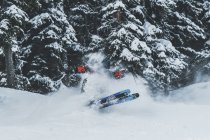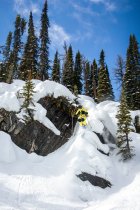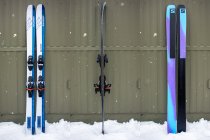Let's be real here. The QST 106 Echo is a QST 106 with a core swap. On paper, it's one of the most pointless skis on the market. Well, kind of. But it's so good it had us questioning why you'd buy a regular 106. Sure, if you are heavier or regularly ski a lot of icy groomers or heavy crud the extra weight helps (but then why are you one a 106 at all?) but damn is the Echo good at dealing with everything for a 'touring ski'.

Groomers & Resort Skiing:
When the conditions are consistent, whether deep, or more firm, the QST 106 Echo is one of the most confidence-inspiring skis we’ve been on at this weight, which means it opens up all sorts of opportunities to get creative. And while it’s not as comfortable skiing switch and spinning as less directional skis, it’s still happy to throw the occasional spin or butter. For a 'touring ski' it's a very confident performer on groomers, and easily matches many non-touring skis.

Powder & Mixed Conditions:
So, the QST 106 Echo is a blast in good snow. Honestly, we’d have been surprised and disappointed if it wasn’t. But, the real test of a touring ski in this weight range is inconsistent snow. And here, the QST 106 Echo provides a big confidence boost. Even in scary, breakable crust, it was easy to anticipate exactly how the Echo would turn. The same goes for firm, chopped up crud. For its weight, the QST 106 Echo does an incredible job of absorbing vibrations, and smoothing out inconsistent snow in a way that allows you to use your energy skiing, not just surviving.

Anytime a ski is slimmed down for backcountry use, it’s bound to lose a little bit of top-end performance in variable snow, and the same is true for the Echo. If you only tour a little, and you want to ski fast, in all conditions, the regular QST will provide a more stable ride but as we already said, not everyone needs that.

Park & Jibbing:
The dampness and stability that the Echo 106 provides in such a light package definitely come at the expense of energy and pop. However, the ski is overall slightly softer than the regular QST, so if we had to pick one of the two to jib on, we'd take the lighter and softer ski for sure. The same goes for hitting a backcountry jump. These do have some tail rise and a relatively modern shape so they can handle some mellow freestyle skiing but if we're being realistic, they are far from optimal.
Who's it for?
Most West Coast or European skiers could happily daily drive these at the resort. Particularly if you like a lighter ski, or are on the lighter end of the human scale. Chuck a SHIFT 2.0 on them and you probably have the closest thing possible to a hybrid resort/touring setup possible. For bigger skiers there is more of a decision to make, you might not want these as your only ski, but they'd still be a very valuable sidecountry or backcountry tool.
Groomers & Resort Skiing:
When the conditions are consistent, whether deep, or more firm, the QST 106 Echo is one of the most confidence-inspiring skis we’ve been on at this weight, which means it opens up all sorts of opportunities to get creative. And while it’s not as comfortable skiing switch and spinning as less directional skis, it’s still happy to throw the occasional spin or butter. For a 'touring ski' it's a very confident performer on groomers, and easily matches many non-touring skis.
Skier: Lucas Boudreau. P: Hanne Lundin Wallengren
Powder & Mixed Conditions:
So, the QST 106 Echo is a blast in good snow. Honestly, we’d have been surprised and disappointed if it wasn’t. But, the real test of a touring ski in this weight range is inconsistent snow. And here, the QST 106 Echo provides a big confidence boost. Even in scary, breakable crust, it was easy to anticipate exactly how the Echo would turn. The same goes for firm, chopped up crud. For its weight, the QST 106 Echo does an incredible job of absorbing vibrations, and smoothing out inconsistent snow in a way that allows you to use your energy skiing, not just surviving.
Skier: Bailey Lahure. P: Carter Edwards
Anytime a ski is slimmed down for backcountry use, it’s bound to lose a little bit of top-end performance in variable snow, and the same is true for the Echo. If you only tour a little, and you want to ski fast, in all conditions, the regular QST will provide a more stable ride but as we already said, not everyone needs that.
Skier: Lucas Boudreau. P: Hanne Lundin Wallengren
Park & Jibbing:
The dampness and stability that the Echo 106 provides in such a light package definitely come at the expense of energy and pop. However, the ski is overall slightly softer than the regular QST, so if we had to pick one of the two to jib on, we'd take the lighter and softer ski for sure. The same goes for hitting a backcountry jump. These do have some tail rise and a relatively modern shape so they can handle some mellow freestyle skiing but if we're being realistic, they are far from optimal.
Who's it for?
Most West Coast or European skiers could happily daily drive these at the resort. Particularly if you like a lighter ski, or are on the lighter end of the human scale. Chuck a SHIFT 2.0 on them and you probably have the closest thing possible to a hybrid resort/touring setup possible. For bigger skiers there is more of a decision to make, you might not want these as your only ski, but they'd still be a very valuable sidecountry or backcountry tool.


